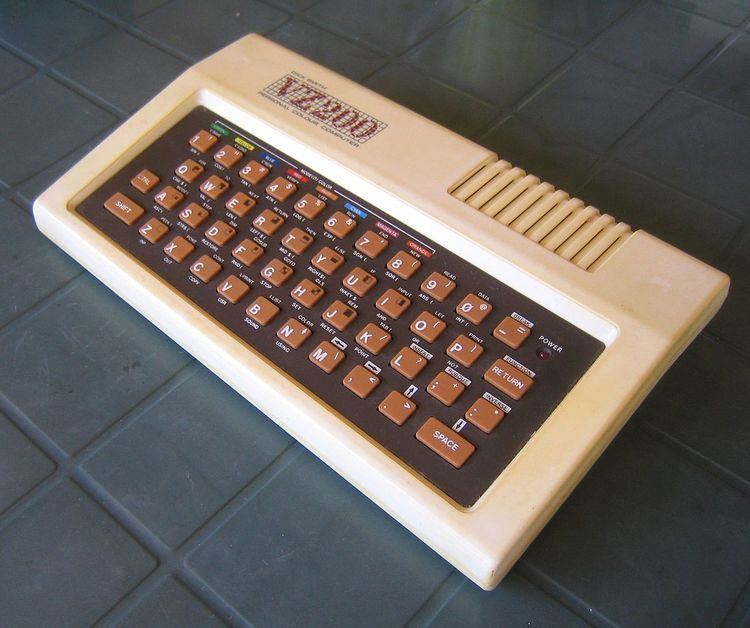Manufacturer Video Technology Introductory price $99USD
£98GBP | Type Personal Computer Units sold 200,000 in Australia | |
 | ||
Release date November 1983; 33 years ago (1983-11) Discontinued 1985; 32 years ago (1985) | ||
The VTech Laser 200 was an early 8-bit home computer from 1983, also sold as the Salora Fellow (mainly in Fennoscandia, particularly Finland), the Texet TX8000 (in the United Kingdom) and the Dick Smith VZ 200 (in Australia and New Zealand).
Contents
The machine ran basic games on cassette such as "Hoppy" (a version of Frogger), "Cosmic Rescue" (Scramble), "VZ Invaders" (Space Invaders) and Moon Patrol. The computer was discontinued in 1985 to make way for more advanced home computers.
Release
At its UK launch, Texet claimed that the £98 TX8000-branded version was the cheapest colour home microcomputer on the market. However, this was not enough to ensure its success against the dominant ZX Spectrum and similar machines already on sale. Most notably, the Spectrum-like Oric-1 was selling for £99 at this point, and offered a far higher specification than the Texet for little difference in cost.
The "Dick Smith"-badged VZ 200 was more successful in Australia, where it proved popular as a first computer.
An improved version known as the VTech Laser 310, or the Dick Smith VZ 300 featured a full travel keyboard and 8K ROM software based Floppy Disk Controller, was released in 1985 and continued until 1989.
Technical specification
The Laser 200 was designed and built by Video Technology (VTech) in Hong Kong and derived from the Tandy TRS-80. Based on a Zilog Z80A CPU driven by a television colour burst crystal (3.5795454 MHz), it offered 16 KB of ROM containing Microsoft BASIC Level II, 8 kB RAM (2 kB of this is VRAM) and four-colour graphics at a resolution of 128×64 or 64×32, or 32 columns and 16 lines of eight-colour text. Because there is only 2 kB of VRAM, only one of the video display modes of the MC6847 Video Display Generator (VDG) chip is available, effectively disabling the higher resolution 256×192 mono colour mode. There were a few unofficial "mods" developed that increased the VRAM and enabled the 256×192 mode that the MC6847 was capable of, a number of programs were written (mainly) by German user groups that used this particular modification. Rather crude sound effects could be achieved by a built-in push/pull piezo speaker via its BASIC, though 1-bit synth and sampling sound can be produced through both raw Z80 assembly as well as libraries within the Z88 Development Kit.
The BASIC interpreter was similar to that offered in the Video Genie but with many of the advanced BASIC commands disabled be default. Various utilities were written to re-enable these commands.
Laser 310
The Laser 310 was released in 1985 throughout parts of Europe and the United States. It was named and sold as the The "Dick Smith" VZ 300 throughout Australia and New Zealand. Also based on a Zilog Z80A CPU with a slightly updated 16k ROM version, it was driven by a television colour burst (3.54 MHz) crystal. It came with 16k of RAM for programming, along with the same 2k of Video Ram as that of the Laser 200. With its release in Australia and New Zealand, commercially based software titles grew and were distributed throughout the Big W and Dick Smith Electronics store fronts.
Peripherals
Within a year of the Laser 310's release, an 80k disk drive unit was released on to the market, of which two could be connected to the computer at the same time. A plug-pack cartridge containing the DOS ROM was required to operate the drives. The DOS ROM and diskette drives were backwards compatible with the Laser 200. A number of other VTech designed plug-in peripherals were also available for both the Laser 200 and Laser 310 computers. Among them were joysticks, cassette drive, light pen, printer plotter, 75 baud MODEM, word processor cartridge, and the 16k and 64k extended RAM cartridges. As numbers of users grew, so did the number of home-made kits which were on offer, which included a Speech synthesizer, SN6847AN music synthesizer, EEPROM programmer, data logger, 300 baud MODEM, full 101 keyboard, and a RTTY Ham radio kit.
Emulators
A number of emulators have since been written for these models of computers:
